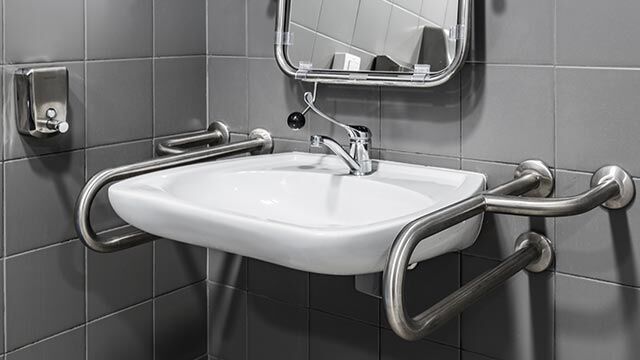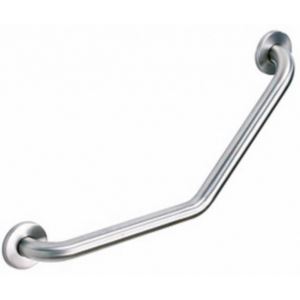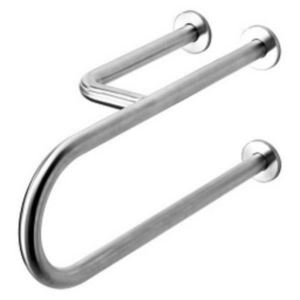Handles for disabled people

What to pay attention to when buying a bathroom handle?
A bathroom designed for people with limited mobility must be functional and ergonomic. It is important to use solutions that create optimal conditions for independent use of the toilet for disabled individuals.
Examples of such amenities are special bathroom handles and handrails. They provide stable support, allowing older and disabled individuals to move more freely. They also provide a sense of security, making hygiene tasks more comfortable.
Faneco offers a wide selection of sanitary handles in various sizes and shapes. They are essential equipment for public facilities. What should you keep in mind when choosing accessories from this category?


Solutions for people with mobility limitations: which handle for disabled individuals to choose?
Handles and handrails prevent falls (especially in places where there is a risk of slipping) and provide necessary support, for example when getting up from a wheelchair or using the toilet. The type of handle that will work best for people with disabilities depends primarily on the location where it will be installed and its function.
Straight handles
The most versatile option. They can be installed in the shower, above the bathtub, or near the toilet.
Corner handrails
L-shaped models are the best choice for shower cabins. They can also be installed vertically or horizontally. Handles with a wider angle (around 120°) provide stable support when getting up.
Curved handrails
Most commonly installed in pairs, for example as handrails on both sides of the sink or next to the toilet. They are available in fixed and foldable versions. The latter is the optimal solution for small spaces. When not in use, they can be easily folded, saving space. This also helps to maintain cleanliness in the bathroom, making cleaning easier.
The type of handle installed in a particular location has a huge impact on the comfort of using the bathroom for people with disabilities. Therefore, it is important to ensure that appropriate accessories are installed in different areas.
Safe and functional handles for people with disabilities
Bathroom handles serve many functions; they can, for example, facilitate movement around the room, help maintain balance, or protect against slipping. For people using wheelchairs, they often serve as assistance when transferring to the toilet or shower seat.
In each of these situations, the main task of the handles is to ensure that the person with disabilities using them can feel comfortable and safe. That is why it is so important not to skimp on quality and not to choose products that are not certified or do not have the appropriate user declarations (especially information about the maximum load).
The certificates awarded to Faneco stainless steel handles are proof that they have undergone rigorous quality controls and that each stage of their production was closely monitored.
High-quality stainless steel and careful workmanship make these accessories stand out for their durability and longevity. An additional advantage is the solid mounting systems; thanks to them, the entire structure is stable and can be relied upon.
How to choose an aesthetic handle for people with disabilities?
Although safety and functionality are essential for handles, aesthetics should not be forgotten. Their selection should be well thought out. When choosing specific products, make sure they will match the other elements of the bathroom decor.
White handles are considered the most universal. The neutral color and simple form make them truly suitable for most arrangements. However, they look best in rooms filled with light shades, furnished in a rather classic style.
To emphasize the character of a modern bathroom, it is worth choosing stainless steel handles. Faneco offers models with various types of finishes:
-
glossy - polished, in the natural color of metal. They perfectly enliven minimalist bathrooms,
-
matte - also in the natural color. They look good in practically any interior,
-
black - made of powder-coated steel, with a matte finish. They are irreplaceable in loft and japandi style bathrooms; they also work well in minimalist arrangements.
Steel handles perfectly complement the bathroom fittings available in the Faneco offer. Matching these elements together will make the entire decor appear cohesive and well thought out in every detail.
Easy installation, maximum comfort - handles for the disabled with simple installation
Handles for the disabled from Faneco are proof that solid installation does not have to be complicated or time-consuming. These accessories have wall or floor mountings, six- or nine-screw; with the aesthetics of our solutions in mind, they have been equipped with special screw covers. No technologically advanced solutions are needed to install them.
Some handles can also be installed horizontally or vertically. This makes them an even more versatile solution for any room.
Is it worth considering the price when choosing bathroom handles?
As we have already mentioned, when choosing bathroom handles, one cannot skimp on quality or the attestations or test results that confirm it. But does this mean that the more expensive the product, the better? Of course not!
Above all, it is important to remember to choose handles that have an attestation and information about the maximum load. In this group, you can find models from different price ranges. The cheapest are usually products made of plastic. However, this does not mean low quality. Modern plastics are very durable and long-lasting; the favorable price is mainly due to lower material and processing costs compared to steel products.
Places of public utility with handles for the disabled
Although Faneco's offer is mainly aimed at equipping public toilets, many of our products also work well in other facilities. These include handles for people with disabilities.
Accessories of this type are worth installing not only in bathrooms. In fact, they will come in handy in any place where people with disabilities are present. They will be particularly helpful near potential architectural barriers, such as stairs or high thresholds. A good idea may also be to install handrails on the walls of a long corridor in a hospital, hotel, school or shopping center.
In fact, these types of facilities should be present in many different public utility facilities, such as:
-
schools, kindergartens,
-
workplaces, offices, production plants,
-
offices and other similar institutions,
-
hotels, guesthouses and other hotel facilities,
-
restaurants, bars, clubs, cafes,
-
shopping malls and entertainment centers.
When considering their placement, it is worth using your own imagination and empathy. If possible, it is also good to consult with people with various disabilities. This is the best way to make the facility a little more friendly for them.

 Polski
Polski
 Český
Český
 Deutsch
Deutsch
 Spanish
Spanish
 French
French
 Italian
Italian